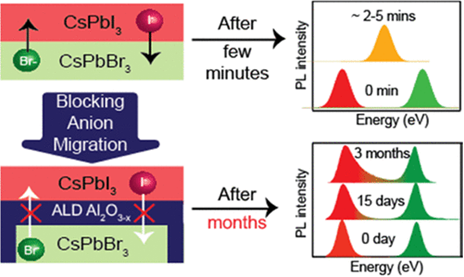An innovative approach to mitigate anion migration and improve perovskite stability using an ultrathin alumina layer can help fabricate halide perovskite-based multilayer optoelectronic devices, e.g., white LEDs.
Light-emitting diodes (LEDs) are widely recognized for their energy efficiency compared to traditional incandescent bulbs, offering the same level of illumination with significantly less power consumption. Consequently, LEDs have emerged as the preferred lighting option, contributing to reduced electricity bills and alleviating strain on power grids, particularly during peak usage periods. Additionally, colored LEDs can be strategically deployed for specific applications; for instance, red and blue LEDs are favored for greenhouse plant growth lighting due to their energy efficiency relative to full-spectrum lighting.
A considerable amount of research attention, both in India and abroad, is directed toward quantum dots, which exhibit high luminescence and hold promise for colored LEDs. Perovskite quantum dots represent a novel class of materials with distinct characteristics ideal for generating vibrant LED displays. Through precise control over the size and composition of perovskite quantum dots during synthesis, scientists can tailor their emission to achieve desired colors for full-color displays. However, challenges persist in perovskite quantum dot research, notably their susceptibility to moisture and heat, which can compromise performance and lifespan within LEDs. When different-colored perovskite quantum dots are layered to produce white light, anion migration—a reaction—occurs, causing them to lose their individual colors.

Addressing this issue, scientists from the Centre for Nano and Soft Matter Sciences, Bengaluru, an autonomous institute of DST have developed an innovative approach to mitigate anion migration between distinct perovskite quantum dot films. They achieved this by embedding an ultrathin alumina layer, grown via atomic layer deposition (ALD), within the perovskite quantum dot layers. This methodology effectively impedes anion migration over extended periods as alumina demonstrates chemical inertness and optical transparency within the visible spectrum. Led by Dr. Pralay K Santra, a Scientist from CeNS, the research team investigated the chemical mechanisms underlying anion migration suppression through alumina. The work has been published in the Chemistry of Materials 2024, 36, 1719.
The strategy offers valuable insights for fabricating halide perovskite-based tandem optoelectronic devices.






























